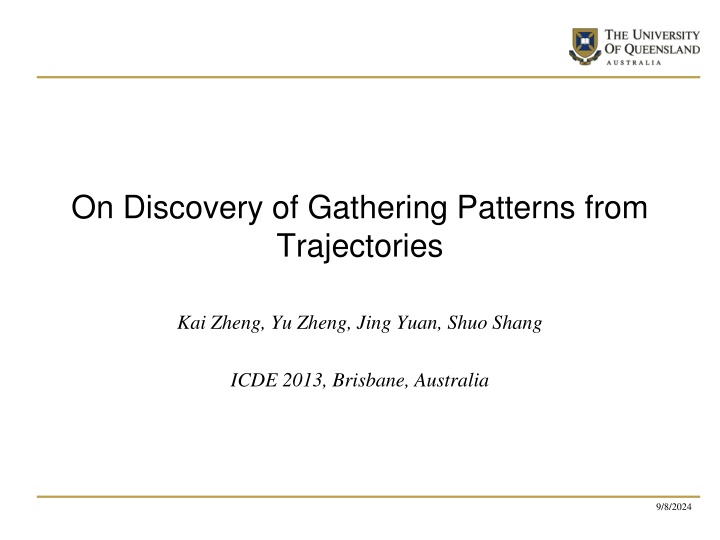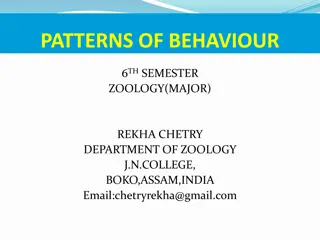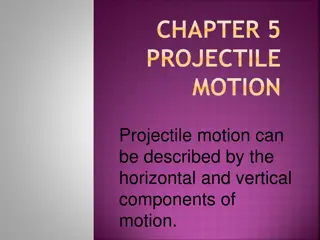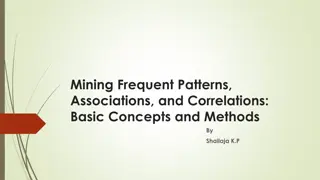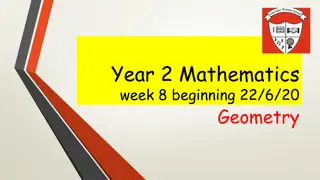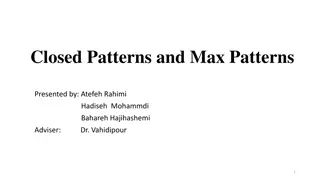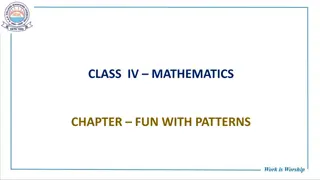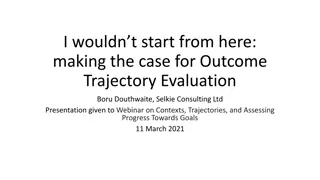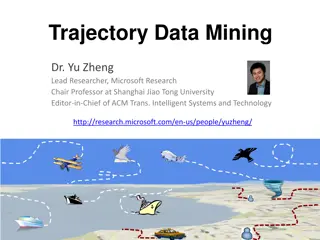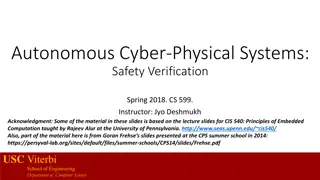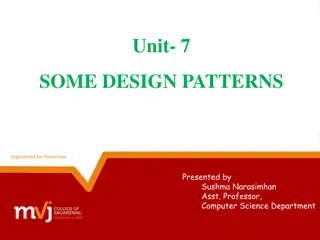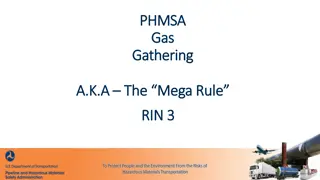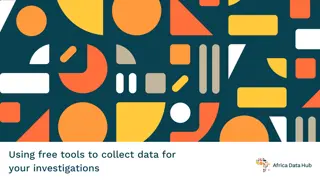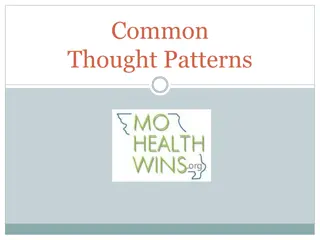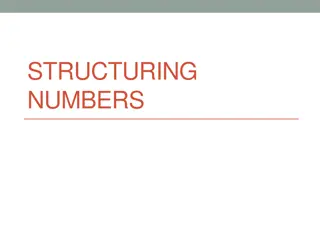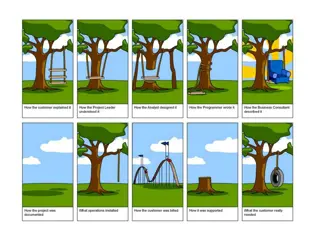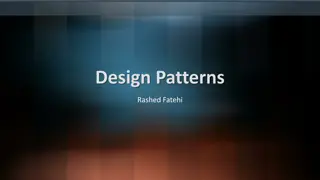Analysis of Gathering Patterns from Trajectories - ICDE 2013
Prevalence of trajectory data due to location acquisition technology enables understanding movement behaviors, group travel patterns, and anomaly detection. Co-travellers patterns like Flocks, Convoys, and Swarms are defined based on group characteristics. Gathering patterns involve events with congregations of moving objects like celebrations, protests, and traffic jams for sensing, monitoring, and early response. Attributes of gathering patterns include scale, density, durability, stationariness, and commitment.
Download Presentation

Please find below an Image/Link to download the presentation.
The content on the website is provided AS IS for your information and personal use only. It may not be sold, licensed, or shared on other websites without obtaining consent from the author.If you encounter any issues during the download, it is possible that the publisher has removed the file from their server.
You are allowed to download the files provided on this website for personal or commercial use, subject to the condition that they are used lawfully. All files are the property of their respective owners.
The content on the website is provided AS IS for your information and personal use only. It may not be sold, licensed, or shared on other websites without obtaining consent from the author.
E N D
Presentation Transcript
On Discovery of Gathering Patterns from Trajectories Kai Zheng, Yu Zheng, Jing Yuan, Shuo Shang ICDE 2013, Brisbane, Australia 9/8/2024
Background Prevalence of trajectory data Advance of location-acquistion technology Easier to track moving objects Huge amount, diverse type Usefulness of trajectory data Understand periodic/regular/specific movement behaviour of individuals Obtain travel patterns of groups in certain areas (traffic analysis) Detect abnormality/event that trigger lots of movements Trajectory data analysis Storage and indexing (e.g., spatio-temporal indexing) Query processing (e.g., range, knn, etc) Mining and pattern discovery (e.g., clustering, co-travellers patterns) 9/8/2024 2
Co-travellers Pattern A group of objects that move together for sufficiently long time Representative definitions Flock (2008 Benkert et al, 2009 Vieira et al, 2006 Gudmundsson et al) Convoy (2008 Jeung et al, 2012 Tang et al) Swarm (2010 Li et al) Difference Pattern Flock Convoy Swarm Definition of group Disc-based cluster Density-based cluster Density-based cluster Time requirement Consecutive Consecutive Non-consecutive strict flexible 9/8/2024 3
Co-travellers Pattern (cont.) Threshold of co-travelling time period: 2 timestamps Flock: O2, O3, O4 O5 is a co-traveller, but no included Convoy: O2, O3, O4, O5 O1 is not in cluster when t=2 Swarm: all five objects 9/8/2024 4
Gathering Pattern: intuition Informally, it represents some group events or incidents that involves congregation of moving objects For example: Celebrations Parades Protests Traffic jams/accidents Motivation Sensing, monitoring, predicating significant event Making plans early Quick emergency response 9/8/2024 5
Attributes of gathering pattern Scale Typically involves a large number of individuals Density High density (but with arbitrary shapes) Durability Last for sufficiently long time period Stationariness The geometric properties (e.g., shape, location) do not change rapidly Existing co-travellers patterns do not desire this Commitment Dedicated members exist, who participate the event for certain (possibly non-consecutive) time period To exclude the dense areas (e.g., busy road intersections) 9/8/2024 6
Problem we studied Formulating the definition of gathering pattern How to find patterns quickly from a large trajectory set How to find patterns incrementally when new trajectory data come 9/8/2024 7
Definition of crowd Input Trajectories of moving objects Odbwithin certain time domain Assumption: location snapshot is available for each object at each time instant (some pre-processing may be required such as interpolation) Snapshot cluster: density-based cluster of location snapshot Thresholds Support threshold mc: how many individuals it contains Variation threshold ? : how rapidly it changes Lifetime threshold kc: How long it will last for Crowd: a consecutive sequence of snapshot clusters At least mcindividuals at any time Distance between any consecutive clusters ? Lifetime > kc 9/8/2024 8
How to measure distance of clusters A cluster is a set of points Hausdorff distance Metric for point set, polygons Intuitively, the Hausdorff distance is the longest distance one can be forced to travel by an adversary who chooses a point in one of the two sets, from where you must travel to the other set Small Hausdorff distance means the location and shape of the cluster do not change much Exactly what we desire! 9/8/2024 9
Definition of gathering pattern Crowd captures the attributes 1 4 No requirement for the commitment of individuals (dedicated member) Participator An object that appears at least kp times in a crowd It may not stay in the crowd continuously Flexible for real scenarios Gathering A crowd that has at least mp participators at any time 9/8/2024 10
Example Two crowds Cra: C1, C2, C4 Crb: C1, C3, C4 C5 moves too fast Participators (kp = 2) Cra: O1, O2, O3, O4 Crb: O2, O3, O5 Gathering (mp = 3) Cra 9/8/2024 11
Approach overview Find snapshot clusters at each time point Perform cluster on simplified trajectories first [2008 Jeung et al] Output: a database of snapshot clusters, CDB Detect all the crowds Deal with large number of clusters at each time instant Hausdorff distance evaluation is expensive Discover gathering patterns Check the occurrences of large number of objects in many crowds Downward-closure does not hold (a gathering doesn t imply its sub- sequences are all gathering) 9/8/2024 12
Crowd detection algorithm Extend until fail Starting from a cluster at current time Extend it with one of the clusters at the next time instant, which is close to it Continue until cannot extend any more Downward-closure property guarantees the correctness Finding the close clusters is quite costly R-tree and grid index for clusters Prune irrelevant clusters based on fast calculation of distance bound Grid index can also reduce the cost of Hausdorff distance evaluation 9/8/2024 13
Gathering discovery Check each crowd if it is a gathering pattern Extend-until-fail does not work Test-and-divide framework Test: if the current sequence is a gathering; if not Divide: remove the invalid clusters Performed recursively until no more crowd exists in any subsequence Example All thresholds are set to 3 Test: C5 only has 2 participators Divide: C1,C2,C3,C4 and C6,C7,C8 Output: C1,C2,C3,C4 Time Need to repeatedly count the occurrences in LONG sequence! 9/8/2024 14
Fast counting Bit Vector Signature Compactly represents the existence of object in each cluster x = B(o1) mask vector Hamming weight The number of 1 bits in a bit vector Within log2(n) bit operations The decimal value is number of 1s in B(o1) 9/8/2024 15
Incremental discovery algorithm New batch of trajectories are collected periodically Keep the results up-to-date Do not re-compute everything from scratch Incremental crowd extension Only certain old crowds are extensible Incremental gathering update Only need to update in the crowd that has just been extended Re-use the information in the old part of the crowd Terminate the test-and-divide process early 9/8/2024 16
Experiment Dataset 33,000 taxicabs in Beijing 120K trajectories 3 months March, April and May in 2009 132,480 time instants (minute) Effectiveness Capture the traffic condition Efficiency Crowd detection Gathering discovery Incremental update 9/8/2024 17
Experiment (cont.) #convoy, swarm, crowd, gathering/day Time of a day Peak time 6am to 10am and 5pm to 8pm Work time 10am to 5pm Casual time 8pm to 5am Weather of a day More gatherings in rainy and snowy weather Moving slowly and minor accidents More gathering in peak time Many crowds, few gathering Many convoys and swarms during peak and casual time -- Convoy and swarm find co-travellers -- Gatherings find dense group of low-speed objects 9/8/2024 18
Experiment (cont.) Crowd detection Two pruning strategies with R-tree Grid-based pruning Gathering discovery TAD: test and divide TAD*: with fast counting Incremental update Divide whole dataset into five groups Sequentially append each group 9/8/2024 19
Conclusion Define the gathering pattern to capture the group events or incidents in real life Efficient discovery algorithms Incremental update upon new arrivals of trajectories Case study for effectiveness of the concept Performance evaluation based on real trajectory dataset 9/8/2024 20
